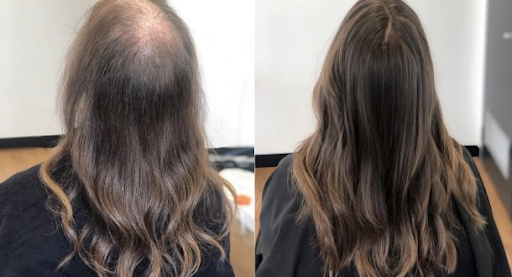If you’re considering using minoxidil, it’s essential to understand what to expect during the treatment process. Here’s a comprehensive overview of the experience you may encounter while using minoxidil.
Initial Expectations
Your main goal while using minoxidil for the first time is probably going to be hair growth. But it’s important to realize that outcomes might not show up right away. There are several phases to the hair development cycle, and minoxidil may take some time to manifest its effects.
Early Weeks
This phenomenon, known as “shedding,” can be alarming, but it is often a sign that minoxidil is working. The shedding occurs as old hairs fall out to make way for new growth. Most users experience this shedding phase around two to four weeks after starting treatment.
Three to Six Months
During this period, new hair follicles begin to enter the anagen (growth) phase. You may start noticing fine, soft hairs, often referred to as “vellus hairs.” These are early signs of new hair growth, and while they may not be immediately noticeable, they signify that minoxidil is having a positive effect.
Six to Twelve Months
As you continue using minoxidil consistently, noticeable improvements in hair thickness and coverage typically become apparent within three to six months. Many customers report less thinning hair and more volume at the six-month mark. Anticipate the most notable outcomes to appear about one year from now. Complete outcomes might take a year or longer, according on personal variables including heredity and the degree of hair loss.
Ongoing Use
Consistency is critical when using minoxidil. For optimal results, apply it daily as directed, typically twice a day. Skipping applications can slow progress and hinder results.
Phase of Maintenance
After getting the results you want, you’ll need to keep taking minoxidil to keep your hair growing. When therapy is stopped, the hair development cycle resets and new hair may start to fall out in a few months. If you choose to discontinue taking minoxidil, get advice from a medical expert on how to do it safely.
Potential Side Effects
Common side effects include:
- Scalp Irritation: This can manifest as redness, dryness, or flaking. If irritation occurs, consider reducing the frequency of application or consulting a dermatologist for advice.
- Unwanted Hair Growth: Some people may see unwanted hair growth on their faces or necks. When minoxidil gets into touch with these regions, this generally happens. Make careful to properly wash your hands after applying to avoid this.
- Dizziness or Rapid Heartbeat: Though rare, some individuals may experience these symptoms. If they occur, discontinue use immediately and seek medical advice.
Monitoring Progress
Tracking your progress during treatment can help you stay motivated and informed. Take photos every few months to visually document changes in hair density and thickness.
Lifestyle Factors to Take Into Account
Think about taking a comprehensive approach to hair health in addition to utilizing minoxidil. Hair development may be favorably impacted by eating a well-balanced, vitamin- and mineral-rich diet, staying hydrated, and controlling stress. Frequent exercise can help improve blood circulation, which benefits the general health of the scalp.
Taking a comprehensive approach to hair health in addition to taking minoxidil will greatly improve your outcomes. A number of lifestyle choices can have a good effect on scalp health and hair development.
Balanced Diet
Biotin, found in eggs, nuts, and whole grains, supports keratin production, which is vital for hair strength. Iron-rich foods like spinach, lentils, and red meat help improve blood circulation to hair follicles. Omega-3 fatty acids, present in fatty fish, flaxseeds, and walnuts, contribute to scalp health by keeping it hydrated and reducing inflammation.
Hydration
Staying adequately hydrated is equally important. Water helps maintain the health of hair cells and supports overall bodily functions. Aim to drink at least eight glasses of water daily, and consider consuming hydrating foods such as cucumbers, oranges, and watermelon to boost your hydration levels.
Stress Reduction
Stress management is crucial for the health of hair since long-term stress can cause hair loss. By using these methods on a regular basis, you may lower stress hormones and improve the environment in which hair grows.
Frequent Workout
Regular exercise can help to increase blood flow throughout your body, particularly to your scalp. Exercise encourages the development of hair follicles by supplying them with vital nutrients and oxygen. Every day of the week, try to get in at least 30 minutes of moderate exercise—whether it’s cycling, running, walking, or any other activity you love.
Sleep
Lastly, prioritize quality sleep. Aim for 7-9 hours per night to allow your body to repair and regenerate. By integrating these lifestyle considerations with minoxidil treatment, you can create a comprehensive approach to achieving healthier, fuller hair.
Conclusion
Treating hair loss with minoxidil in Australia can be successful, but it’s important to know what to anticipate from the medication. Patience and consistency are essential during the hair loss process, from the beginning to the end. You can get the most out of minoxidil and help your path to better hair by following the application instructions and leading a healthy lifestyle. Throughout your therapy, if you have any questions or concerns, always get in touch with a healthcare provider.
